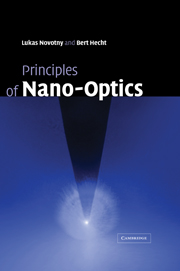Book contents
- Frontmatter
- Contents
- Preface
- 1 Introduction
- 2 Theoretical foundations
- 3 Propagation and focusing of optical fields
- 4 Spatial resolution and position accuracy
- 5 Nanoscale optical microscopy
- 6 Near-field optical probes
- 7 Probe–sample distance control
- 8 Light emission and optical interactions in nanoscale environments
- 9 Quantum emitters
- 10 Dipole emission near planar interfaces
- 11 Photonic crystals and resonators
- 12 Surface plasmons
- 13 Forces in confined fields
- 14 Fluctuation-induced interactions
- 15 Theoretical methods in nano-optics
- Appendix A Semianalytical derivation of the atomic polarizability
- Appendix B Spontaneous emission in the weak coupling regime
- Appendix C Fields of a dipole near a layered substrate
- Appendix D Far-field Green's functions
- Index
5 - Nanoscale optical microscopy
Published online by Cambridge University Press: 05 June 2012
- Frontmatter
- Contents
- Preface
- 1 Introduction
- 2 Theoretical foundations
- 3 Propagation and focusing of optical fields
- 4 Spatial resolution and position accuracy
- 5 Nanoscale optical microscopy
- 6 Near-field optical probes
- 7 Probe–sample distance control
- 8 Light emission and optical interactions in nanoscale environments
- 9 Quantum emitters
- 10 Dipole emission near planar interfaces
- 11 Photonic crystals and resonators
- 12 Surface plasmons
- 13 Forces in confined fields
- 14 Fluctuation-induced interactions
- 15 Theoretical methods in nano-optics
- Appendix A Semianalytical derivation of the atomic polarizability
- Appendix B Spontaneous emission in the weak coupling regime
- Appendix C Fields of a dipole near a layered substrate
- Appendix D Far-field Green's functions
- Index
Summary
Having discussed the propagation and focusing of optical fields, we now start to browse through the most important experimental and technical configurations employed in high-resolution optical microscopy. Various topics discussed in the previous chapters will be revisited from an experimental perspective. We shall describe both far-field and near-field techniques. Far-field microscopy, scanning confocal optical microscopy in particular, is discussed because the size of the focal spot routinely reaches the diffraction limit. Many of the experimental concepts that are used in confocal microscopy have naturally been transferred to near-field optical microscopy. In a near-field optical microscope a nanoscale optical probe is raster scanned across a surface much as in AFM or STM. There is a variety of possible experimental realizations in scanning near-field optical microscopy while in AFM and STM a (more or less) unique set-up exists. The main difference between AFM/STM and near-field optical microscopy is that in the latter an optical near-field has to be created at the sample or at the probe apex before any interaction can be ineasured. Depending how the near-field is measured, one distinguishes between different configurations. These are summarized in Table 5.1.
Far-field illumination and detection
Confocal microscopy
Confocal microscopy employs far-field illumination and far-field detection and has been discussed previously in Section 4.3. Despite the limited bandwidth of spatial frequencies imposed by far-field illumination and detection, confocal microscopy is successfully employed for high-position-accuracy measurements as discussed in Section 4.5 and for high-resolution imaging by exploiting nonlinear or saturation effects as discussed in Section 4.2.3.
- Type
- Chapter
- Information
- Principles of Nano-Optics , pp. 134 - 172Publisher: Cambridge University PressPrint publication year: 2006
- 2
- Cited by



